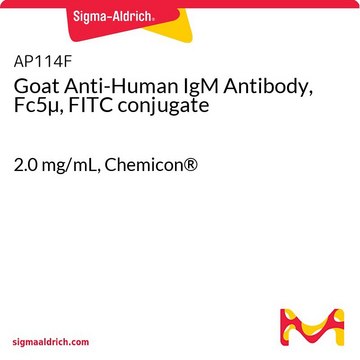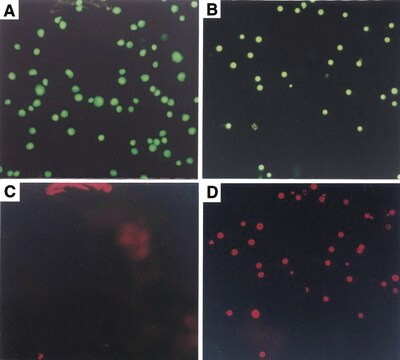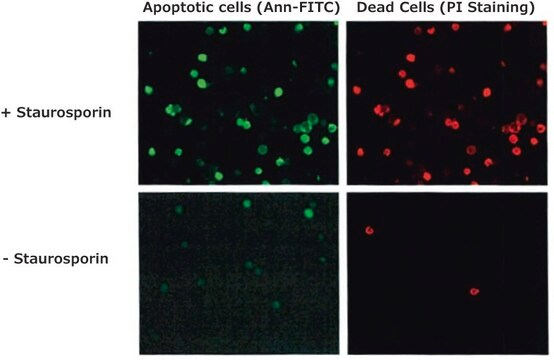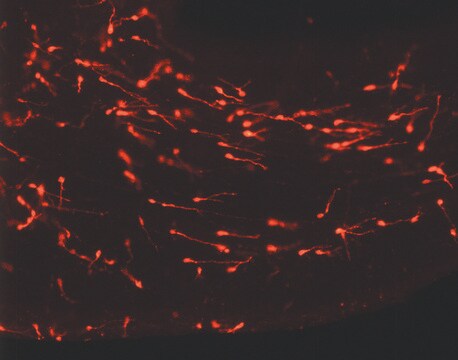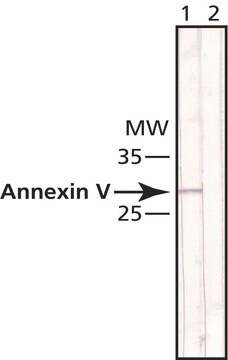APOAF
Annexin V-FITC Apoptosis Detection Kit
Synonym(s):
Annexin V-FITC, Apoptosis probe FITC
Sign Into View Organizational & Contract Pricing
All Photos(2)
About This Item
UNSPSC Code:
12352207
NACRES:
NA.84
Recommended Products
usage
(20 tests)
Quality Level
packaging
pkg of 1 kit
technique(s)
flow cytometry: suitable
application(s)
cell analysis
detection
detection method
fluorometric
shipped in
wet ice
storage temp.
2-8°C
General description
Annexin V-FITC kit allows fluorescent detection of annexin V bound to apoptotic cells and quantitative determination by flow cytometry. The AnnexinV-FITC kit uses annexin V conjugated with fluorescein isothiocyante (FITC) to label phosphatidylserine sites on the membrane surface. The kit includes propidium iodide (PI) to label the cellular DNA in necrotic cells where the cell membrane has been totally compromised. This combination allows the differentiation among early apoptotic cells (annexin V positive, PI negative), necrotic cells (annexin V positive, PI positive), and viable cells (annexin V negative, PI negative).
Application
Annexin V-FITC Apoptosis Detection Kit was used:
- in staining of LNCaP prostate cancer cells for measuring the G. lucidum extracts activity during the treatment of prostate cancer.
- for tumor cell labelling to study the inhibitory activity of DBP-maf (Vitamin D binding protein-macrophage activating factor) on prostate tumor cells.
- for indirect measurement of flippase activity.
Features and Benefits
Detects apoptosis earlier in the process than DNA-based assays such as TUNEL.
- Rapid labeling of cells. Cell staining takes only 10 minutes.
- No cell fixation or processing required, reducing the detection time and allowing the cells to be used for further study.
- Propidium iodide secondary dye is included with the kit to differentiate apoptotic cells from viable and necrotic cells.
Other Notes
Allow all components to reach room temperature before use.
Kit Components Only
Product No.
Description
- APOAFA
related product
Product No.
Description
Pricing
Storage Class Code
10 - Combustible liquids
Certificates of Analysis (COA)
Search for Certificates of Analysis (COA) by entering the products Lot/Batch Number. Lot and Batch Numbers can be found on a product’s label following the words ‘Lot’ or ‘Batch’.
Already Own This Product?
Find documentation for the products that you have recently purchased in the Document Library.
Customers Also Viewed
Monika Kallubai et al.
Journal of biomolecular structure & dynamics, 37(3), 623-640 (2018-01-30)
Our study focus on the biological importance of synthesized 5β-dihydrocortisol (Dhc) and 5β-dihydrocortisol acetate (DhcA) molecules, the cytotoxic study was performed on breast cancer cell line (MCF-7) normal human embryonic kidney cell line (HEK293), the IC50 values for MCF-7 cells
Denise C Arruda et al.
The Journal of biological chemistry, 287(18), 14912-14922 (2012-02-16)
Complementarity-determining regions (CDRs) from monoclonal antibodies tested as synthetic peptides display anti-infective and antitumor activities, independent of the specificity of the native antibody. Previously, we have shown that the synthetic peptide C7H2, based on the heavy chain CDR 2 from
Ben-Zion Zaidman et al.
International journal of oncology, 31(4), 959-967 (2007-09-06)
Ganoderma lucidum (Curt.:Fr.) P. Karst, a medicinal fungus, has been widely used in Asian countries for centuries to prevent or treat a variety of diseases, including cancer. However, the mechanisms responsible for the effects of G. lucidum on cancer cells
Juliana Rizzo et al.
Eukaryotic cell, 13(6), 715-726 (2013-12-18)
Flippases are key regulators of membrane asymmetry and secretory mechanisms. Vesicular polysaccharide secretion is essential for the pathogenic mechanisms of Cryptococcus neoformans. On the basis of the observations that flippases are required for polysaccharide secretion in plants and the putative
Kalvin J Gregory et al.
PloS one, 5(10), e13428-e13428 (2010-10-27)
Vitamin D binding protein-macrophage activating factor (DBP-maf) is a potent inhibitor of tumor growth. Its activity, however, has been attributed to indirect mechanisms such as boosting the immune response by activating macrophages and inhibiting the blood vessel growth necessary for
Articles
Cellular apoptosis assays to detect programmed cell death using Annexin V, Caspase and TUNEL DNA fragmentation assays.
Our team of scientists has experience in all areas of research including Life Science, Material Science, Chemical Synthesis, Chromatography, Analytical and many others.
Contact Technical Service

